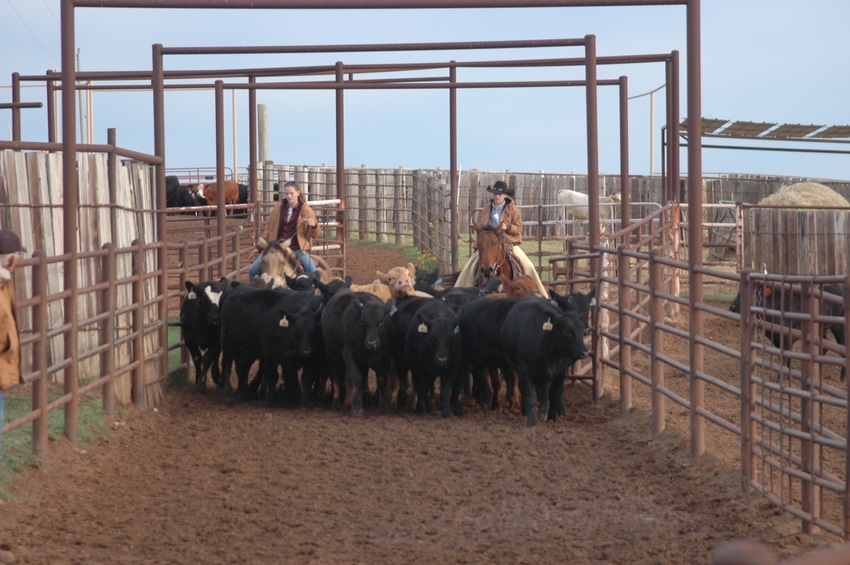If you found last week’s blog helpful, read on. Here are more tips on how to handle cattle better.

It seems that many of you found last week’s blog, “5 things to consider when working cattle,” helpful. So I thought I’d follow up this week with more tips from the Stockmanship and Stewardship program recently at Colorado State University.
Ron Gill, a longtime Extension beef specialist with Texas A&M University, teamed with Curt Pate, a Montana rancher and cattle handling expert, and Dean Fish, who ranches on Arizona’s border with Mexico, to give a cattle handling demonstration. These are just a sampling of the many bits of great advice I heard.
Curt Pate
Ron used to have a saying that that I disagreed with for quite a while. The only way to work cattle quickly as slowly. You've all heard that. That's such a great saying. But it's a bunch of baloney in some cases if you're working real gentle cattle, like real, real gentle cattle. If you work them slowly, you're just going to make them worse.
I heard a guy in Oklahoma say he added to this a little bit. He said the only way to work cattle quickly is slowly until you learn how much pressure they can take. Now that makes a lot more sense.
So to me, the way to work cattle when you first get them is maybe not so slowly, but without a lot of pressure. You're trying to figure out where the flight zone or the pressure zone is. And if you'd just stampede into them, you just increase the flight zone for one thing and you didn't learn how to work the cattle.
So a way to go about approaching cattle is the flatter your angle, the less pressure you're putting on. That's real important to understand. And the reason that is, when you flatten your angle, they can see you with two eyes. They want to see you with two eyes.
Watch how she puts her feet down. Good. She'll stay there for a minute because she put her foot down soft.
If you want to improve your stockmanship more than anything else, move your pressure from the tail to that triangle in the neck.
READ: Temple's top animal handling tips
Dean Fish
When you're pulling cattle, keep changing their mind. And every time they do something right, let them know they did something right. So the release of pressure is almost as important as how you put the pressure on.
You just got to think you're right. If you're wrong, just start over again.
READ: Yes, there's a premium for BQA-certified cattle
Ron Gill
Sometimes we get so focused on only bringing that one out, sometimes it will be a whole lot easier to bring several out, sort them off and leave the one. You're trying to reduce stress. So if you get in a fight with the one, that's not going to help.
When one leaves (the chute), you want the one behind it to see what's happening. Most hot shot use on the cow-calf operation happens right there behind the chute. But nine times out of 10 they're letting that one out and then opening the back gate. And when you do that, you've lost your draw and you've lost your flow.
This heifer in the front, I stuck my hand in there and ran it down her back. That's enough stimulus that you don't normally have to hot shot one. If you're working for a company that won't let you stick your hand in there, you can take a stick and run down their back. But it's front to back. Start about their withers and go down their back and they'll squirt forward. But you've got to have a place for them to go. Don't start all that until you’ve got a place to go.
If you're moving pairs, the thing you want to try to do is to get the cow to get her calf up and leave with it. If cattle are afraid of you, they'll run off and leave those calves. So when you first go to a pasture, you probably ought to get away from the cattle. Ride your horse back and forth to warm it up, whatever.
So those cows know you're out there, they get their calf and leave with them. Once you've done that, they'll take them with them rest of the day. But if you trot them off before they pair up, they never pair up. So it’s really important how you start that. And put somebody in front to slow the cows down.
If you’re getting ready to process at a cow-calf operation, you get cattle loaded the snake and then you start filling syringes. Let those cattle run through and mix them back in with cow herd. Then when you get all your syringes filled, just go to catching them and go to treating them. Those you've just run through and getting mixed back in, you create better draw.
About the Author(s)
You May Also Like



